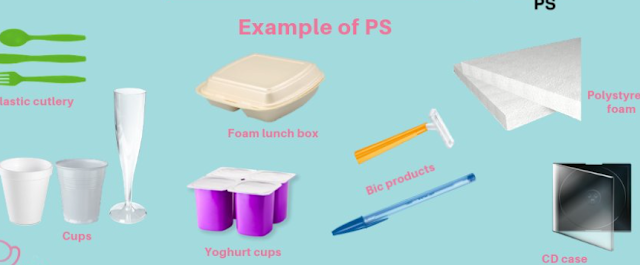Plastic Types, Common uses and Toxicity
Available types of Plastic their differences, uses, toxicity and recycling status are discussed below.
Toxicity of plastic types is indicated with the color; green being safer and red showing most toxic affect to human health and environment.
- Polyethylene Terephthalate (PET)
This type of plastic is the most like to come into physical contact in our daily life, It can be completely rigid or flexible depending upon the manufacturing process, and due to its molecular construction, it has chemical and weather resistant and a terrific water and gas barrier.
Properties: Clarity, lightness, toughness, barrier to liquid and gas, toughness
Common uses :
Soft drink, water bottles, cooking oil bottles, packaging trays, frozen ready-meal trays, First-aid blankets, polar fleece.
Toxicity: It may leach antimony (antimony trioxide is used as a catalyst and flame retardant in PET). The longer the liquid is present in the PET container, the greater the releasing potential. High temperature inside the vehicle and enclosed storage area can lead to the release of antimony into the liquid. Antimony trioxide is considered a possible carcinogen. Exposure to antimony trioxide for long periods of time has exhibited respiratory and skin irritation and, among female workers, increased incidence of menstrual problems and miscarriage.
Note: there is no evidence that the above-mentioned effect may arise with exposure to the small antimony released from the PET product. (i.e., Water bottle). But it should be avoided from high temperature.
Can it be Recycled?
One of the most commonly recycled types of plastics.
Alternative use: Use glass or stainless-steel bottles and reuse them.
2. High-Density Polyethylene (HDPE)
Incredibly strong considering of HDPE is its density, HDPE is a solid material that can tolerate high temperatures and strong chemicals.
Common uses :
Plastic bags (grocery), Cleaning solution and soap containers, food, and drink containers, shopping bags, garbage bags, pipes, insulation, bottle caps, vehicle fuel tanks, protective helmets, dishes, faux-wood planks, recycled wood-plastic composites.
Toxicity: It is considered as the safer plastic for food and drink container use due to its higher stability. It can leach endocrine disruptor nonylphenol, which is used for product stabilization.
Can it be Recycled?
HDPE is regularly used because it can be recycled in many different ways and therefore converted into many different things. Recycled items made into bottles for a non-food item like shampoo, detergent, motor oil, plastic lumber and furniture, fencing, floor tiles, buckets, film, and sheeting …..
3. Polyvinyl Chloride (PVC)
The second most widely used plastic resin is PVC plastic after polyethylene. Although it is Cost-effective to produce and highly resilient to chemical and biological damage, use has decreased due to serious health and environmental pollution issues during its manufacturing process, use, and after use. PVC can be mold into any shape easily, making it an extremely practical material.
Properties:
PVC is one of the most versatile materials.
Common uses:
Soft PVC is used to make toys, clear food, and non-food packaging. furniture, clothing, medical containers, cooking oil and peanut butter jars, tubing, water, and sewage pipes,
squeeze bottles, shampoo bottles, mouthwash bottles, flooring, cladding, vinyl records, cables, cleaning solution containers, water bottles.
Toxicity: Most toxic type of plastic. Can leach various toxic chemicals like bisphenol A (BAP), lead, mercury, cadmium.......
Asthma and allergic symptoms in children living in homes where PVC dust was present can cause cancer, including breast cancer.
Can it be Recycled?
Very low recycling rate.
4. Low-Density Polyethylene (LDPE)
It can be very thin or thick but usually flexible and easily torn. A common living temperature LDPE is a highly non-reactive material, so it has become one of the most common plastics in the current scenario. It is not as strong as HDPE and can withstand 100 degrees centigrade, and it is certainly more resilient.
Common uses :
Trays, containers, protective shells, computer hardware casings, playground fixtures (slides and the like), bin-bags, laundry bags. coatings for paper milk cartons, hot & cold beverage cups
Toxicity: IT is considered as the safer plastic due to its relative stability
Can it be Recycled?
Difficult to recycle, the rate is very low.
5. Polypropylene (PP)
will tear or pull apart depending on the form. Strong and flexible, polypropylene (PP) is a very hard-wearing plastic. Its application is similar to the polyethylene but generally stiffer and higher tolerance to high heat resistance relative to other plastics.
Common uses :
food containers (ketchup, yogurt, cheese,.......) Clothing, surgery tools, and supplies, hobbyist model, bottle caps, straws, crisp bags, kettles, lunch boxes, packing tape.
Toxicity: Being relatively stable, it is considered a safer plastic
Can it be Recycled?
Low rate, because often pigmented or mixed with other resins, therefore difficult to sort and recycle.
6. Polystyrene or Styrofoam (PS)
Will shatter into stripes if compressed; caps will usually be too hard to flex. Polystyrene is generally associated with the Styrofoam food containers and packing peanuts made of expanded PS (EPS), which is essentially foamed PS that has been puffed up with air. PS synthesis requires benzene, a known carcinogen, to form the monomer styrene, which is reasonably anticipated to be a human carcinogen.
Common uses :
Styrofoam food containers, egg cartons, disposable cups and bowls, take-out food containers, deli food plates, packaging, packing peanuts, bike helmets.
Toxicity: Can leach styrene, reasonably anticipated to be a human carcinogen.
Can it be Recycled?
Very low rate
7. Other
This type of plastic is very tough and is likely to shatter if pressure is applied.
Common uses:
Reading glasses, CDs, DVDs, and cases, some electric connection (insulator)
Can it be Recycled?
Reuse the items to avoid recycling.















2 Comments
Very helpful article💪
ReplyDeleteThank you and keep on visiting us.
Delete